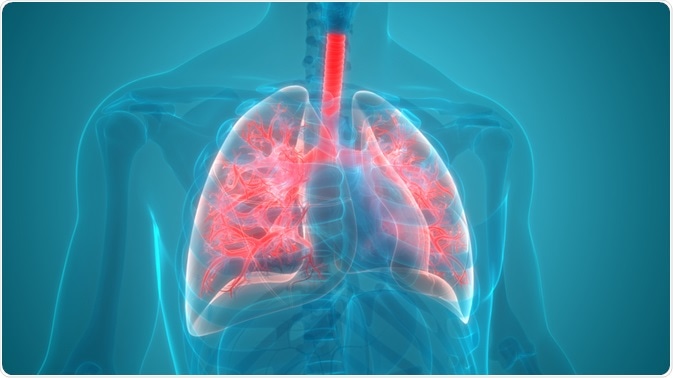Chronic obstructive pulmonary disease (COPD) is a medical condition where damage to the airway leads to a chronic inflammatory response. In this case study, scientists from Peking and Shanghai identified novel protein biomarkers from exhaled air condensate provided by patients with COPD. These samples were analyzed by liquid chromatography coupled to mass spectrometry (LC-MS).
The research is featured in the Journal of Proteomics.
Skip to:

Magic Mine | Shutterstock
COPD is associated with long periods of smoke inhalation, e.g. from cigarettes or burning of biomaterials. The smoke irritates the tissues of the airways, eliciting inflammatory responses and subsequently, breathing difficulties.
In the late stages of the disease, the inflammatory reaction does not cease when the exposure to smoke inhalations ends. Hence, it is of great interest to identify new biomarkers for the early detection of COPD.
The search for COPD biomarkers has focused on the analysis of exhaled air, which contains aerosols produced when air passes through the airways. Exhalations are usually trapped in condensation chambers as exhaled air condensates (EAC) that can be analyzed by conventional techniques.
While several biomarkers have been found in previous research, EAC samples are usually small and insufficient for extensive analysis. In fact, previous investigations had to use pooled EAC samples from multiple patients or control participants, instead of analyzing each individually.
Researchers from China and Shanghai university hospitals in collaboration with scientists from CapitalBio Technology Inc. demonstrated that EAC samples from individual study participants can be used for proteomics analysis by nano ultra-high performance liquid chromatography coupled to Orbitrap mass spectrometry (nanoLC-Q-MS).
Tandem Mass Tag Multiplexing for High Throughput Proteomics
The investigators conducted a clinical study with adult COPD outpatients aged 40-75 years and compared their results against healthy study participants of the same age range. Around 2ml samples of EACs were collected and the protein fraction prepared for proteomics by standard techniques (protein purification followed by enzymatic digestion to peptide fragments).
For multiplexing, a tandem mass tag (TMT) was used. TMTs are molecules with functional groups that react with proteins and peptides. In tandem mass spectrometry, these tags disintegrate into specific fragments with known mass spectrometry profile (i.e. mass-per-charge signal). Thus, multiple protein samples can be analyzed in a single run and be discerned from the fragmentation pattern of the individual TMT tag.
Specificity is achieved by locating the non-radioactive isotopes C-13 and N-15 in known molecular positions of different TMT labels, so while the different TMT molecules contain the same number of carbon and nitrogen isotopes and have the same mass (they are “isobaric”), the fragments in tandem MS will be different dependent on the location of the isotope labels.
Identifying New Biomarkers from Inflammatory Pathways
The scientists identified 257 proteins in their EAC samples of which 234 proteins were observed both in COPD patient samples and healthy study participants. In contrast to previous studies where samples from several participants had to be pooled due to insufficient sample size, the investigators thus showed that the ca. 2 ml EAC volumes were sufficient for the sensitive nanoLC coupled to Orbitrap MS.
Quantitative protein analysis revealed that 24 proteins were significantly differentially regulated (DR), with 15 up- and 9 downregulated proteins. Of these DR proteins, six proteins were found that had not been observed in previous studies on COPD. These proteins were part of the mitogen-activated protein kinase (MAPK) pathway, which is well known for its role in signaling pathways for inflammatory responses.
A Biomarker for Early or Late COPD Detection?
The research suggested that proteomics of exhalations by LC-MS can indicate COPD, however, the identified biomarkers need to be validated in additional, independent clinical studies.
Most importantly, longer-term studies will be required to demonstrate at which stage of COPD progression the biomarkers become significant, to determine whether they can serve as early- or late-stage indicators of COPD. The study authors plan to evaluate this in a clinical trial of which the biomarker search featured here was the first part.
Source
Sun C et al. (2019). Proteomics of exhaled breath condensate in stable COPD and non-COPD controls using tandem mass tags (TMTs) quantitative mass spectrometry: A pilot study. Journal of Proteomics. DOI: 10.1016/j.jprot.2019.103392.
Acknowledgments
The study authors acknowledge the proteomics analysis by CapitalBio Technology Inc., whose scientists were not co-authors of the study. The authors note that this study was registered at www.clinicaltrials.gov and received approval from the Peking University Institutions Review Board Office.
Further Reading
Last Updated: Sep 9, 2019